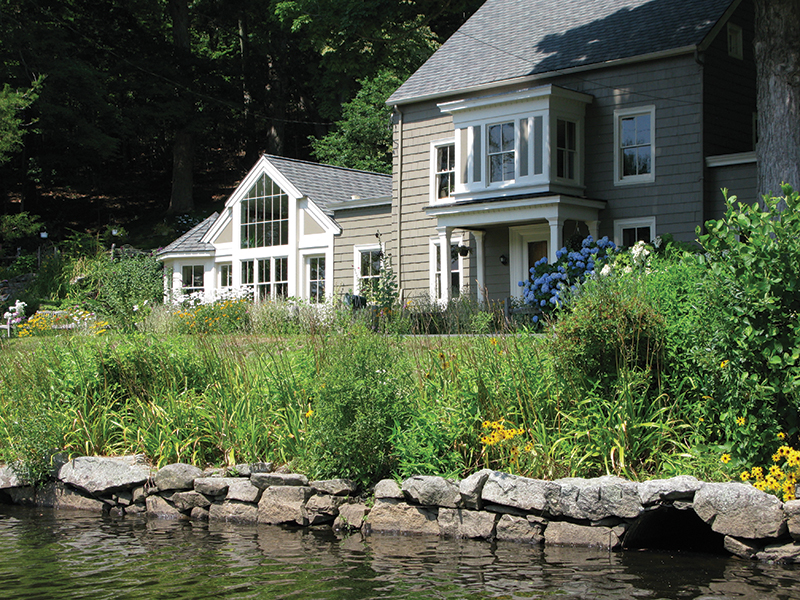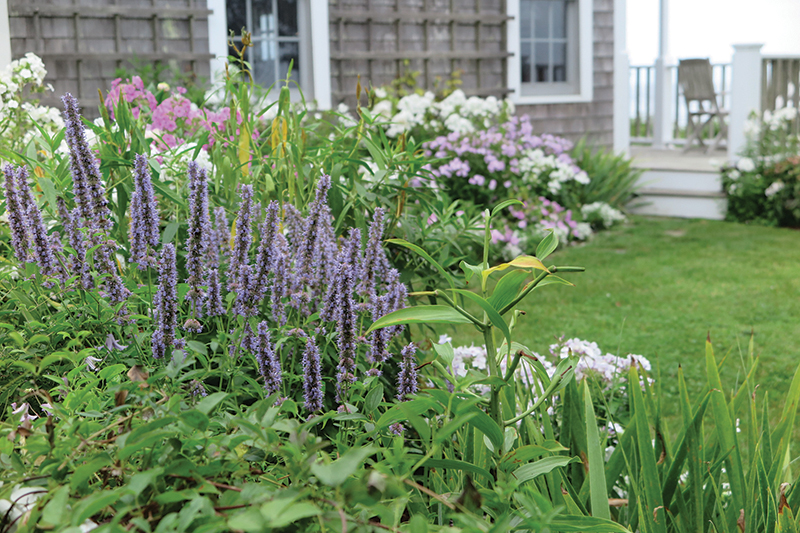
Lawn Care We Can Live With
Why this spring is a good time to turn over a new leaf

If your lawn borders a waterbody, even a modest buffer of herbaceous plants and shrubs can help breakdown or prevent pollutants from impacting water quality.
Ah, spring. For the gardeners among us it is the long-awaited return to being outside, smelling the soil, welcoming the sun. And regardless of how you spent your winter months—planning or just anticipating—the gardening season is now upon us. And suddenly there’s oh so much to do.
If you have a lawn, you know all too well that before long the ritual will begin: it is the season of mowers and spreaders, trimmers, bags of seed and fertilizer. And that’s where I’d like to encourage a pause: that fertilizer.
Gardening for Good is more than just about gardening tradition; it’s about rethinking how the way we’ve always done things can be tweaked to accommodate our growing awareness and understanding of how the world is changing, or perhaps more accurately, how we are changing the world. And because the Connecticut River, its estuary, and Long Island Sound beyond have a huge stake in our actions, it’s a good time to rethink fertilizer.

Smaller lawns can complement diverse gardens that provide visual appeal along with important resources for pollinating insects.
Although not less time consuming, the ecological benefits of this alternative are noteworthy.
The most challenging part of talking about the impacts of fertilizer to wetlands and watercourses is not being able to point to it as it is happening. When nitrogen and phosphorus leave the fertilizer bag, the rest is largely invisible: it is absorbed by plants until they have had their fill, and any extra soon makes that silent journey toward the sea. Nutrients will move through the soil into the water table, or be dissolved in surface water that leaves the lawn after a heavy rainfall either directly into a wetland or stream, or emptied onto the road where it is channeled into a storm drain and discharged to the nearest waterbody, untreated. This “stormwater impact” to our waters can and does have significant, cumulative consequences to one of nature’s—and humankind’s—most relied-upon resources: clean water.
 The impacts include the more dramatic fish kills and algae blooms that make it to the headlines, but the subtle consequences—just like the invisible nature of the fertilizer’s journey from lawn to water—are more difficult to quantify. Now more than ever before the state of the environment is muscling its way into our news feeds. The causes of climate change are not a mystery anymore, and seeking ways to collectively make a difference—and not feel so helpless in the face of global turmoil—is worth something.
The impacts include the more dramatic fish kills and algae blooms that make it to the headlines, but the subtle consequences—just like the invisible nature of the fertilizer’s journey from lawn to water—are more difficult to quantify. Now more than ever before the state of the environment is muscling its way into our news feeds. The causes of climate change are not a mystery anymore, and seeking ways to collectively make a difference—and not feel so helpless in the face of global turmoil—is worth something.
There’s an entire continuum of ways that our lawn and garden care can make a difference. So, what can we live with? Here are some of the most important actions to take.
If your existing lawn is unfertilized and the result is acceptable to you, then don’t start fertilizing. If you’re using a mulching mower that returns grass clippings to your lawn, you’re already adding nitrogen: 46 percent to 59 percent of applied nitrogen ends up in these clippings, reducing the need for more added nitrogen by 25 percent to 40 percent.
If you believe nitrogen is necessary—and only a nitrogen-specific soil test will tell you that for certain—then the advice coming from UConn scientists who are nutrient experts and concerned about water quality is to apply one-half to one-third less fertilizer than the package recommends. Avoid combination products, the familiar “weed and feed” merchandise that has you buying a different formula for different times within the growing season. In addition to increasing the chances of overfeeding, these products can contain one-size-fits-all amendments, including pesticides, that are better applied to specific problem spots, if needed.
Despite the age-old practice of applying fertilizer before a good rain to help it soak in, it is more likely to result in excess nutrients ending up in the storm drain—especially as our rain is increasingly arriving in more concentrated downpours. And although this might seem logical, don’t run your fertilizer spreader over the sidewalk or driveway, where it will concentrate unused nutrients that will ultimately end up in the nearest storm drain.
At the other end of the spectrum, during periods of drought, added fertilizer will not be taken up by your lawn, unless supplemental water is provided (an increasingly unsustainable use of potable water).
The best one-time application for lawn fertilizer is, surprisingly, not spring, but fall, between mid-September and mid-October. Nitrogen applied in fall, when the soil is warm, will benefit root growth that will help your turf survive winter conditions and be ready to grow in the spring. To efficiently use nitrogen (or phosphorus), the soil needs to be above 55 degrees Fahrenheit, which requires caution at either end of the growing season. You can measure soil temperature by using an inexpensive soil thermometer inserted to a four-inch depth. If you have your heart set on two applications of fertilizer (any more than that is overfertilizing) apply after the spring green-up, and in the fall no later than October 15th.
On a final note, the type of fertilizer you use can also make a difference: slow-release fertilizers are less likely to burn the grass, and organic slow-release (which is an alternative to petroleum-based synthetic fertilizer) works with soil microorganisms in healthy soil to breakdown and release nutrients over a longer period. But remember: too much fertilizer is too much fertilizer, whether it’s organic or inorganic.
It is estimated that 40 percent of the nitrogen entering Long Island Sound comes from the Connecticut River and its watershed. Although human wastewater is the primary culprit, fertilizer has been identified as a significant contributor, and one that can be curtailed. And there are good reasons to reduce your lawn in favor of more diverse and ecologically important habitat for wildlife, including our native pollinators. More to come on that.
Judy Preston is a local ecologist active in the Connecticut River Estuary.

